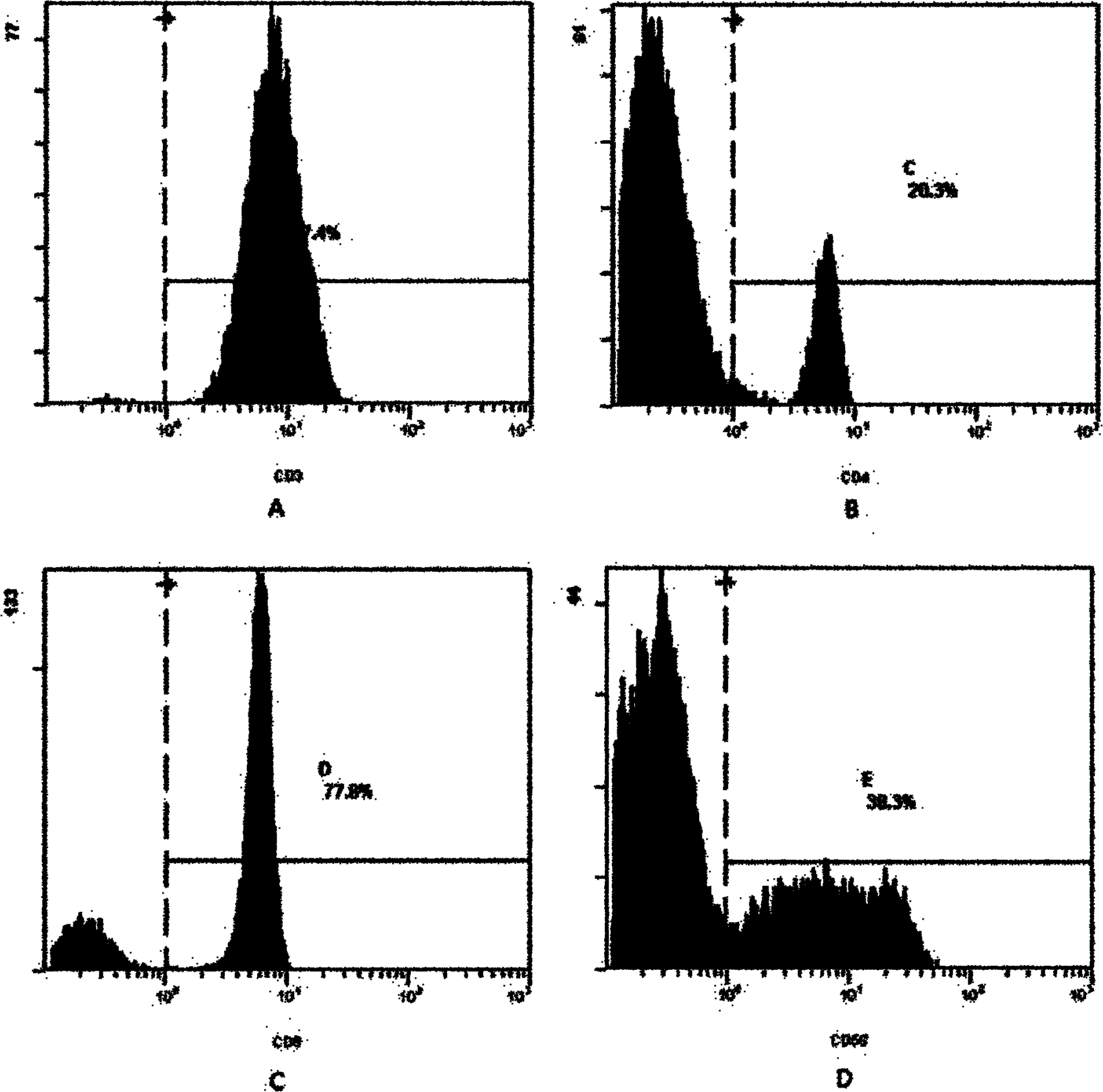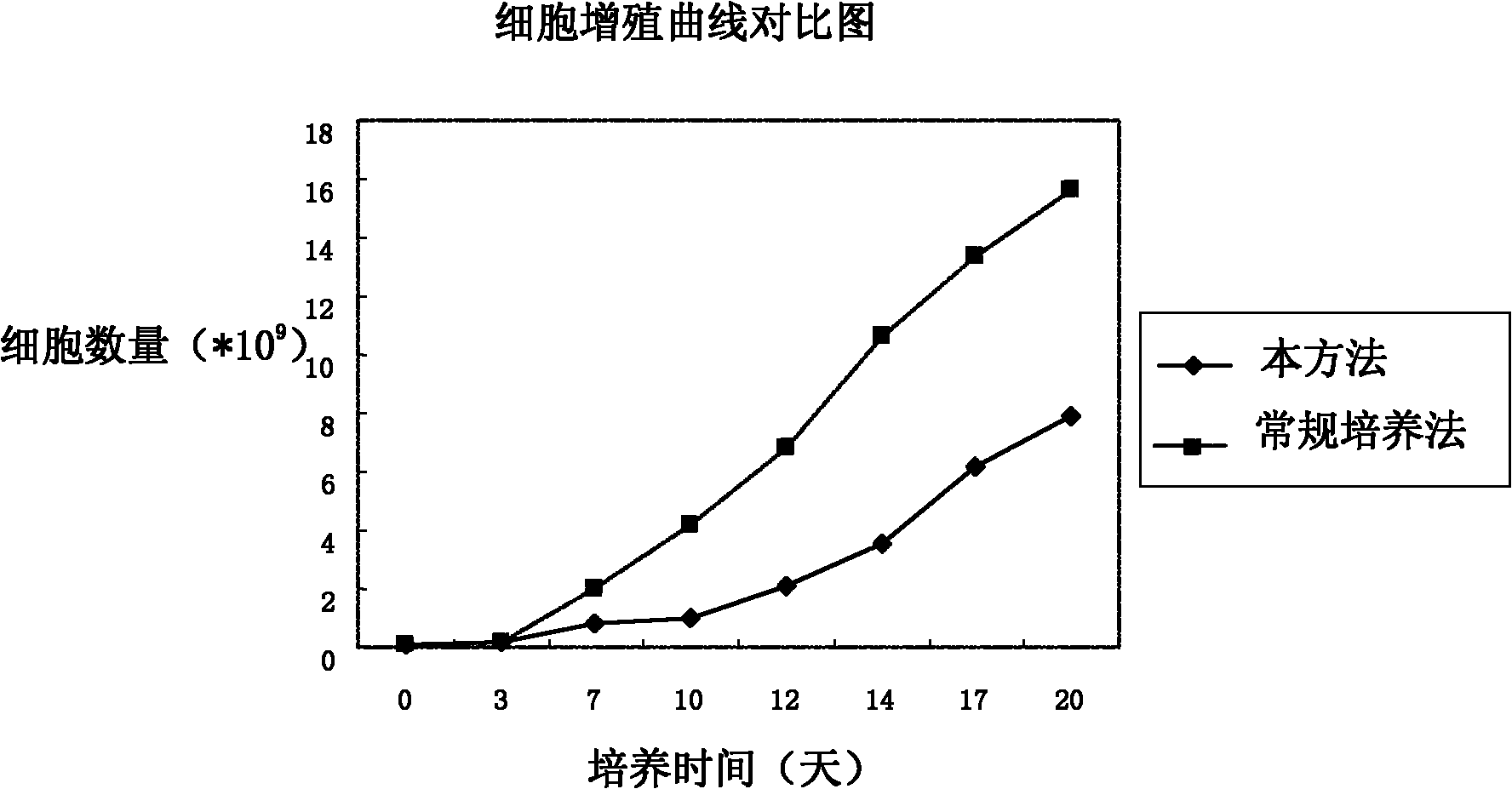Preparation method of antitumor adoptive immune cells and prepared immune cells
An immune cell and anti-tumor technology, which is applied in the field of preparation of immune active cells and anti-tumor adoptive immune active cells, can solve the problems of large side effects of treatment and difficult cell sources, and achieves increasing cell proliferation multiples, improving induction effect, and improving The effect of the overall tumoricidal effect
- Summary
- Abstract
- Description
- Claims
- Application Information
AI Technical Summary
Problems solved by technology
Method used
Image
Examples
Embodiment 1
[0041] The collection and separation of embodiment 1 peripheral blood mononuclear cells (PBMC):
[0042] Aseptically extract 40-45ml of peripheral blood, add it into a 50ml centrifuge tube with heparin saline according to the blood culture operation, shake gently, and fully anticoagulate. Dilute 1:1 with normal saline and put into two 50ml centrifuge tubes. Slowly add (25ml lymphocyte separation medium, 4 50ml centrifuge tubes) on the interface of the separation medium. Centrifuge at room temperature, 2000rpm: 20 minutes. Aspirate the PBMCs, transfer them into four new 50ml centrifuge tubes, add normal saline to 50ml, and blow gently with a straw to mix. Centrifuge for 20 minutes and discard the supernatant. Resuspend the cells in 4 centrifuge tubes with normal saline, combine them into 1 centrifuge tube, add normal saline to 50ml, mix well, take 20ul of samples and count. Centrifuge and wash 50ml of the cell suspension twice at 2300rpm for 10 minutes; discard the supernat...
Embodiment 2D
[0043] Example 2 DC induction and amplification:
[0044] Gently blow the above-mentioned cells adhered to the wall for 3 hours with a pipette, suck out the non-adhered cells and the culture medium, transfer them into a 50ml centrifuge tube, and centrifuge at 2300rpm for 10 minutes. The supernatant was added back to the plate along the side. Add GM-CSF 1000 μg / ml; IL-4 1000 μg / ml, culture at 37° C., 5% CO2. After that, add factors (GM-CSF, IL-4) and AIM-V medium every day to adjust the cell density to 1*106 / ml. After culturing until the 7th day, add autologous tumor tissue lysate and dendritic cell maturation-promoting factor to the culture dish, so that the final concentration of lysate protein is 50 μg / ml, and the final concentration of maturation-promoting factor is 500 μg / ml. On the 8th day, add GM-CSF 1000μg / ml; IL-4 1000μg / ml, cultured at 37°C, 5% CO2, matured on the 9th day, and collected DC.
[0045] Preparation method of autologous tumor cell lysate:
[0046] Draw...
Embodiment 3
[0047] Induction and expansion of embodiment 3 CIK cells:
[0048] Dissolve 1 tube of Retronectin 2.5 mg in 250 ml of normal saline in advance to make a coating solution with a final concentration of 10 μg / ml. Take 10ml of coating solution and put it on T-75cm 2 in a culture flask and let stand overnight. On the second day, the coating solution was discarded, and the culture flask was washed twice with physiological saline to obtain a culture flask coated with Retronectin factor.
[0049] The unattached cells after adherent culture in Example 1 for 3 hours were resuspended with 10ml of AIM-V medium, transferred into a T-75cm2 culture flask coated with Retronectin, added IFN-r1000μg / ml, and incubated at 37°C , 5% CO2 culture environment to continue the culture. On the second day, 2 μg / ml of CD3 McAb, 1 μg / ml of CD28 McAb, and 1000 μg / ml of IL-2 were added to the culture flask. After that, add medium and cytokine IL-2 every day, and adjust the cell density in the culture fla...
PUM
 Login to View More
Login to View More Abstract
Description
Claims
Application Information
 Login to View More
Login to View More - R&D
- Intellectual Property
- Life Sciences
- Materials
- Tech Scout
- Unparalleled Data Quality
- Higher Quality Content
- 60% Fewer Hallucinations
Browse by: Latest US Patents, China's latest patents, Technical Efficacy Thesaurus, Application Domain, Technology Topic, Popular Technical Reports.
© 2025 PatSnap. All rights reserved.Legal|Privacy policy|Modern Slavery Act Transparency Statement|Sitemap|About US| Contact US: help@patsnap.com



